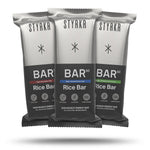Don’t let flavour fatigue ruin your race.
 You have obviously heard of physical fatigue, but have you heard of flavour fatigue? It’s also sometimes called palate fatigue.
You have obviously heard of physical fatigue, but have you heard of flavour fatigue? It’s also sometimes called palate fatigue.
Flavour fatigue occurs when food or drinks become less appealing or even bland, often due to consecutive consumption. This is common in endurance athletes, and it can cause all sorts of unexpected nutritional hiccups that may ruin your event or race.
So what do you do about flavour fatigue? How can you stop it? Continue reading to find out.
What you will learn:
-
What flavour fatigue is and why it is common in endurance athletes
-
What causes flavour fatigue, and why is it a problem
-
How to avoid flavour fatigue for optimal endurance performance
What is flavour fatigue for endurance athletes?
Flavour fatigue occurs when food items become less appealing, often due to repeated consumption.
This fatigue can occur with a specific food, such as bananas, or with a specific food texture, such as energy gels.
For example, if you were to encounter flavour fatigue with energy gels, switching the flavour or even brand might help, but it is not guaranteed — you might just be sick of the gel-like texture.
When flavour fatigue happens, the sensory receptors on the tongue are less responsive to specific tastes, textures, or flavours.
This makes getting nutrition products in and your carbohydrate intake up difficult.
Why flavour fatigue is a problem
When flavour fatigue happens, you may not want to eat or take certain sports nutrition products, like energy gels.
This makes it very difficult to stick to your nutritional plan. Energy gels, bars, bananas, or other foods included in your plan suddenly become the last things you want to eat.
During an endurance event, you want to get a minimum of 60-90g of carbohydrates/hour [2]. For longer events lasting 2.5 hours or multi-day events, this number can be even higher.
Find what works best for you!
Not getting enough carbohydrates during prolonged endurance exercise increases your risk of hitting the wall and bonking. This can quickly ruin your race or event.
To avoid flavour fatigue, athletes should use a mix of different products and real foods [1]. However, it is essential to practice this in training first to see how the gut responds, preventing an upset stomach and a last-minute race disaster, or even a DNF.
How to avoid flavour fatigue
 Flavour fatigue happens when you become sick of the same flavour, texture, or consistency of food items or sports nutrition products.
Flavour fatigue happens when you become sick of the same flavour, texture, or consistency of food items or sports nutrition products.
It’s more likely to happen if your nutritional plan includes a very limited selection of food items.
Even if you can tolerate energy gels for multiple hours during training, you may still experience flavour fatigue during a race or event, despite familiarity during training (this can happen with other foods and nutritional products).
Therefore, it’s a good idea to include a mix of real food and sports nutrition products in your endurance nutrition plan.
Bananas, homemade rice cakes, jam sandwiches, energy bars, gels, chews, sweets, and pretzels are all popular options.
If you are really struggling to get carbohydrates because of flavour fatigue, try drinking your carbs with a carbohydrate sports mix.
Practice using these food items during training, like long runs or cycles and see how your body and gut respond. You don’t want to try new foods on race day — stick to what you know works well for you.
Having a handful of nutritious foods and snacks available helps avoid flavour fatigue and keeps your energy levels topped up, ready to perform at your best.
You may find that mixing so many foods causes your stomach to disagree with you, forcing you to take a different approach. This is why it is so important to practise race day nutrition during training.
Anticipate flavour fatigue
Prepare ahead of time and have backup food items and sports products on hand in case you experience flavour fatigue mid-event.
If you usually use energy gels or bars, add carbohydrate drink mixes, foods like bananas and jam sandwiches, or even sweets for a quick energy boost when needed.
As previously mentioned, practice eating a variety of food items during training and see how your gut responds.
Plan for flavour fatigue to happen and know what you will eat instead to maintain performance.
What does the literature say?
There is currently a lack of academic literature on flavour fatigue for endurance athletes.
However, it is worth noting that environmental factors like heat and dehydration can increase taste perception and palatability. This likely explains why flavour fatigue is common in ultra-endurance and hot-weather events.
To help combat dehydration during endurance exercise, drink plenty of water with added electrolytes, like SLT07. Added electrolytes may also improve palatability, making it easier to stick to your fuelling plan.
Key takeaways
-
Flavour fatigue is when food or drink items become less desirable and appealing
-
It can be a problem because it can be difficult to meet your nutritional demands if you struggle to get enough carbohydrates into your system mid-event
-
Practice consuming a mix of food and drinks during training to see how your gut responds (and to have a backup for race day)
-
Plan ahead and anticipate flavour fatigue — know how you will combat it on the day
References:
-
Blennerhassett, C., 2018. Ultra-endurance Athletes' Food Choices, Nutrition Knowledge and Strategies to Improve Dietary Intake and Performance (Doctoral dissertation, Edge Hill University).
-
Thomas, D.T., Erdman, K.A. and Burke, L.M., 2016. Nutrition and athletic performance. Med Sci Sports Exerc, 48(3), pp.543-568.

